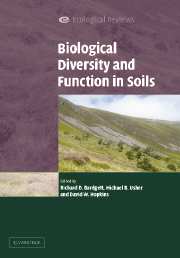Book contents
- Frontmatter
- Contents
- List of contributors
- Preface
- Acknowledgements
- PART I Introduction
- PART II The soil environment
- PART III Patterns and drivers of soil biodiversity
- 5 The use of model Pseudomonas fluorescens populations to study the causes and consequences of microbial diversity
- 6 Patterns and determinants of soil biological diversity
- 7 How plant communities influence decomposer communities
- 8 The balance between productivity and food web structure in soil ecosystems
- 9 Rhizosphere carbon flow: a driver of soil microbial diversity?
- PART IV Consequences of soil biodiversity
- PART V Applications of soil biodiversity
- PART VI Conclusion
- Index
- References
6 - Patterns and determinants of soil biological diversity
Published online by Cambridge University Press: 17 September 2009
- Frontmatter
- Contents
- List of contributors
- Preface
- Acknowledgements
- PART I Introduction
- PART II The soil environment
- PART III Patterns and drivers of soil biodiversity
- 5 The use of model Pseudomonas fluorescens populations to study the causes and consequences of microbial diversity
- 6 Patterns and determinants of soil biological diversity
- 7 How plant communities influence decomposer communities
- 8 The balance between productivity and food web structure in soil ecosystems
- 9 Rhizosphere carbon flow: a driver of soil microbial diversity?
- PART IV Consequences of soil biodiversity
- PART V Applications of soil biodiversity
- PART VI Conclusion
- Index
- References
Summary
SUMMARY
This chapter examines the vast diversity of organisms that live in the soil and discusses the various factors that regulate its spatial and temporal patterning.
There is a dearth of information available on the diversity of soil biota, especially at the species level, but existing data provide little support for the idea that the same forces that regulate patterns of diversity above-ground (i.e. productivity and disturbance) control patterns of biodiversity below-ground, or that regional-scale patterns of soil biodiversity show similar trends to those that occur above-ground.
We argue that patterning of soil biodiversity is related primarily to the heterogeneous nature, or patchiness, of the soil environment at different spatial and temporal scales, and that this heterogeneity provides unrivalled potential for niche partitioning, or resource and habitat specialisation, leading to avoidance of competition and hence co-existence of species.
We highlight the challenge for soil ecologists to identify the hierarchy of controls on soil biological diversity that operate at different spatial and temporal scales, and to determine the role of spatio-temporal patterning of soil biodiversity as a driver of above-ground community assembly and productivity.
Introduction
The Earth hosts a bewildering diversity of organisms that are distributed in a wide variety of spatial and temporal patterns across, and within, the Earth's ecosystems. Making sense of these complex patterns of diversity, and understanding the dominant forces that control them, has been a major theme of community ecology (Huston 1994).
- Type
- Chapter
- Information
- Biological Diversity and Function in Soils , pp. 100 - 118Publisher: Cambridge University PressPrint publication year: 2005
References
- 43
- Cited by

